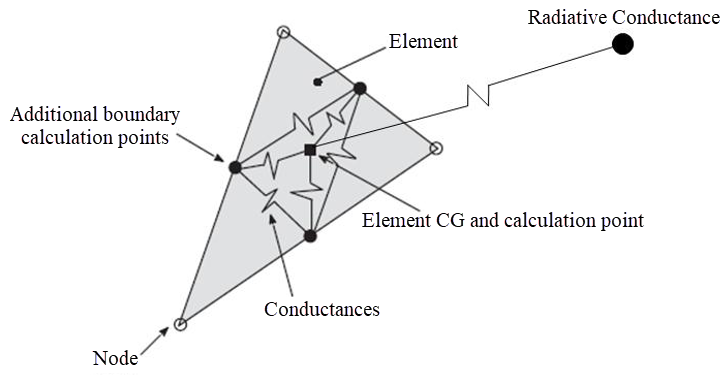Radiative conductance calculation methods
Radiative conductance quantifies the rate at which thermal radiation is exchanged between surfaces. The thermal solver supports several computational methods, each with distinct advantages and limitations depending on the complexity of the geometry, material properties, and computational resources available.
View factors are not sufficient to compute radiative exchange because they only consider geometry. To fully account for radiative heat transfer absorption, emission, and reflection must also be considered.
The radiation exchange is similar to an electrical current. A network of radiative conductances is created based on which faces radiate to each other, and the thermal solver solves for the radiation potential or radiation exchanges.
The radiative conductance-based approach calculates the fraction of total energy emitted from an element that arrives directly at another element. It assumes heat transfer between radiative elements as heat transfer through a radiative conductance and then computes radiative conductances from the element temperature and view factors.
The following image illustrates an element with labeled nodes, conductances, and calculation points, highlighting how radiative conductance connects the element to an external environment for thermal radiation exchange using finite volume method.

Methods for computing radiative conductances
- Gebhardt’s method
-
Gebhardt’s method builds upon view factors by solving a system of equations that accounts for multiple reflections and interactions between surfaces.
- Computational cost: Requires solving N systems of N equations, which can be computationally expensive.
- Matrix characteristics: Produces a dense matrix with many small terms, leading to high memory and storage demands.
- Advantage: Provides a clear and intuitive understanding of heat flow paths.
- Limitation: Not suitable for materials with temperature-dependent material properties.
- Oppenheim radiosity method
- The radiosity method introduces additional unknown variables to model
surface radiosity, which includes both emitted and reflected radiation.
- Computational cost: Adds N more unknown variables to the system, increasing the size but not necessarily the complexity.
- Matrix characteristics: Results in a relatively sparse matrix, which is more efficient to store and solve compared to Gebhardt's method.
- Advantage: Supports temperature-dependent emissivity, making it suitable for more realistic material modeling.
- Limitation: The resulting heat flow paths are less intuitive compared to Gebhardt’s method.
- Monte Carlo method
-
The Monte Carlo method uses statistical sampling to simulate the paths of many radiation particles, making it highly flexible and accurate for complex geometries and optical properties.
- Computational cost: Computationally intensive due to the large number of samples required for accuracy.
- Matrix characteristics: Produces a matrix similar in size and form to that of Gebhardt’s method.
- Advantage: Well-suited for systems with direction-dependent or spectrally varying optical properties.
- Limitation: Not ideal for temperature-dependent material properties due to the complexity of integrating such dependencies.
Comparison
The following table summarizes the key characteristics of the radiative conductance methods.
| Method | Computational cost | Matrix characteristics | Supports temperature-dependent properties | Suitable for complex optical properties | Ease of interpreting heat flows |
|---|---|---|---|---|---|
| Gebhardt’s method | High | Dense, many small terms | No | No | Easy |
| Oppenheim radiosity method | Moderate | Sparse | Yes | Yes | Hard |
| Monte Carlo method | High | Dense, similar to Gebhardt’s | No | Yes | Moderate |
